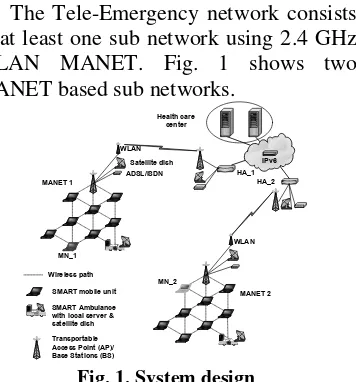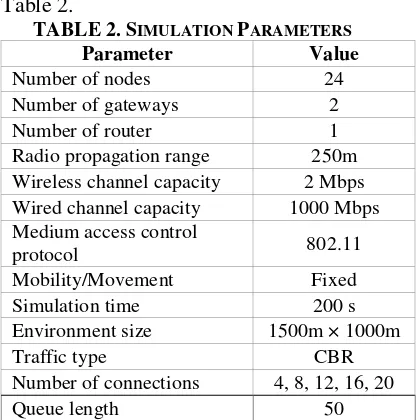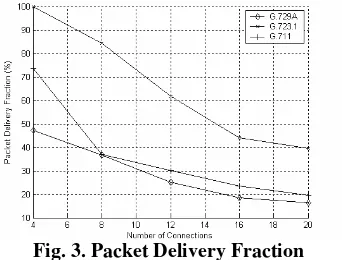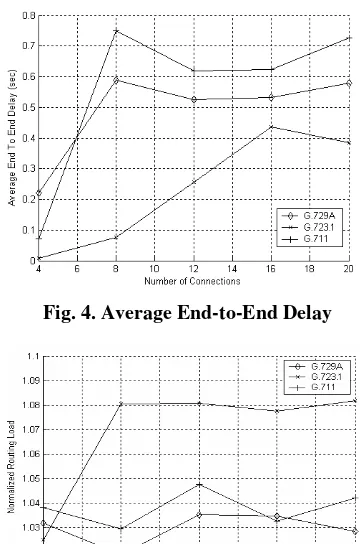COMBINED MOBILE AD HOC NETWORK AND MOBILE IP
FOR MOBILE TELEMEDICINE SYSTEM
E.M. Husni1, M. S. Arifianto2, W. T. H. Woon2, D. V. Viswacheda2, L. Barukang2
1
School of Electrical Engineering and Informatics Institut Teknologi Bandung LSKK, STEI, Jl. Ganesha 10, Bandung 40132, Indonesia
Phone: +62 22 2500 960 Fax: +62 22 2534 217 Email: [email protected]
2
School of Engineering and Information Technology Universiti Malaysia Sabah Locked Bag No. 2073, 88999 Kota Kinabalu, Sabah, Malaysia
Phone: +60 88 320000, Ext: 3437, Fax: +60 88 320348 Email: [email protected]
ABSTRACT
This paper discusses the design of mobile telemedicine for delivering medical health care services in remote areas under the Tele-emergency Project. The system design uses Mobile Internet Protocol version 6 (MIPv6) combined with rapidly deployable network based on Mobile Ad-hoc Network (MANET) and IEEE 802.11 Wireless LAN (WLAN) technology. The result of our preliminary simulation for the project, which is the simulation of VoIP traffic over MANET, is also presented here. The network simulation tool used for this project is network simulator—2 (ns2). The project’s primary objective is to create a prototype of mobile telemedicine system including hardware and software that can be rapidly deployed in remote areas or in disaster situation where telecommunication infrastructures are lacking or destroyed.
Keywords :Mobile Ad-hoc Network (MANET), Mobile IP, WLAN, Telemedicine, Ad-Hoc On Demand Distance Vector (AODV).
INTRODUCTION
Telemedicine is defined as the delivery of medical health care and medical expertise using a combination of telecommunications technologies. Telemedicine systems can support applications ranging from video conference to providing diagnostics, high quality image and still-image, and medical database record.
Lamont et. al. (2002) and Tseng et. al. (2003).
TELE-EMERGENCY REQUIREMENTS AND
APPLICATIONS
The requirements of the Tele-Emergency are:
1. Capable to work in remote areas, which has limited communications infrastructure,
2. Capable of being deployed for emergency condition ,
3. Capable of managing electronic patient records,
4. Supported by real-time multimedia communications and geographical information system (GIS) ,
5. Low operating cost.
Applications in the Tele-Emergency are classified into basic and extended services. Basic services applications are digital electrocardiogram (ECG), oxy-meter (spo2 oxy-meter), patient database record, and location information based on GPS technologies. Extended services applications are complete multimedia services. All services can be used in rural areas based on wireless communication despite hospitals, which have wired communication.
SYSTEM AND NETWORK ARCHITECTURE
Mobile Ad Hoc Network Review
Ad hoc literally means “formed or used for specific or immediate problems or needs”. Thus, MANET means a mobile network which can be formed or used for specific or immediate problems or needs.
Mobile nodes in a MANET communicate to each other without base station, without the aid of any centralized administration hence it is also known as an infrastructure less wireless network. MANET employs its mobile nodes as a
part of the networking system. Each node in MANET can act as an intermediate node, i.e. as a relay to forward packets of data (Toh 2002) and do routing functionality. In MANET, mobile nodes are free to move arbitrarily. It leads to an important property of MANET which is dynamic topology.
foreign network, it acquires a care-of address in addition to its home address. Care-of address is a forwarding address for a roaming mobile node.
In mobile IP, packets destined for the mobile node are always sent to the mobile’s home network. When a mobile node moves to a foreign network, it gets the care-of address from a router in the foreign network, called foreign agent. The mobile node then registers the new node. Packets in the reverse direction from the mobile node can go directly to the corresponding host without going through the home agent.
Mobile IPv6 simplifies the scenario by removing the foreign agent. The mobile node uses IPv6 address auto-configuration procedure to acquire a collocated care-of address (Perkins et. al. 1996), (Johnson et. al. 2002).
Network Architecture
The Tele-Emergency network consists of at least one sub network using 2.4 GHz WLAN MANET. Fig. 1 shows two MANET based sub networks.
!" several Tele-Emergency MNs, and some optional communication devices such as satellite dish, ADSL, and ISDN modem. The server in the mobile ambulance functions as a local database when there is no connection to the health care center. However, the optional satellite communication link and wired terrestrial communication in Fig.1 are used only if the field condition is making them more feasible than using 2.4 GHz WLAN.
The health care center, e.g. hospitals, has its own wireless LAN based medical systems working in the 2.4 GHz ISM band (Konstantinos et. al. 2000).
Tele-Emergency’s Mobility with MIPv6 and MANET
Every mobile node can route packets within a sub network based on a MANET routing protocol. Since mobile nodes can move arbitrarily, the network topology can change according to the ongoing moves.
In Fig. 1, MN_1 is a member of sub for addressing. Each Tele-Emergency mobile node (MN) has a home address (HoA) given by the home agent (HA) in the home network. The home network has a network prefix matching that of the
MN’s home address. When the mobile node is away from home network, it uses the address auto-configuration procedure defined in IPv6 to get a care-of-address (CoA).
When a MN sends packets to another node within the same sub network, the packets will only have to go through a MANET routing protocol.
When MN_1 sends packets to MN_2, which is in a different sub network, the packets go through different types of routing. First, they are sent from MN_1 to the transportable base station in sub network 1 by using a MANET routing protocol, which then forward them to HA_1. HA_1 sends the packets to HA_2 by using IPv6 routing. HA_2 then forwards the packets to the transportable base station in sub network 2. Finally the packets again have to be routed by a MANET routing protocol to go to MN_2.
A mobile node such as MN_1 can move anywhere, anytime in the home network or move into foreign network as shown in Fig. 2. When MN_1 is attached to a foreign network, it obtains a care of address (CoA) and registers it with HA_1. The HA_1 will know the current address and location of the MN_1.
When a correspondent node (CN) such as the server in health care center sends packets towards MN_1’s home address, the packets are intercepted in MN_1’s home network by HA_1 and tunneled to MN_1’s care-of address.
When MN_1 sends packets to the CN, it uses its CoA as source address and puts its HoA in the Destination Options (home address options). MN_1 informs the CN of its new CoA so that subsequent data traffic can be sent directly between MN_1 and CN, without tunneling process to the HA_1. Upon the packet receive by CN; the
HoA replaces the source address so that the applications in CN perceive that it is still communicating with the MN at its HoA. While the CN sends packets to MN_1, it puts MN_1’s CoA in the destination field and the HoA in the type 2 routing header. The same processes are applied to MN_2 when it is moved and attached into a different sub networks.
The macro mobility given by MIPv6 combined with MANET micro mobility within sub network provides seamless mobility for Tele-Emergency MN.
Fig. 2. Tele-Emergency mobility with MIPv6
SIMULATION
Simulation of MANET
The simulation integrates WLAN and ad hoc network to form a wireless-cum-wired environment. The selected routing protocol is AODV, and we use an AODV extension called AODV+ (Hamidian 2003).
The performance of AODV+ is evaluated by running simulations on ns2 which is a discrete event simulator developed by the University of California at Berkeley and the VINT project (Fall & Varadhan 1997). The AODV+ extensions on ns2 can be obtained (Hamidian -).
(i.e., 2-29 nodes) (Macker & Corson 2004), were randomly placed across the simulation environment of size 1500m×1000m. This closely resembled geographical environment for communications in rural areas.
Since AODV+ was meant to work in wired-cum-wireless environment, two gateways and a router were deployed to provide connection to the Internet. The gateways and routers formed the wired environment and are within the range of each other. The bandwidth capacity is 1000 Mbps while the delay is 0.1 seconds. It is not the purpose of this project to examine the performance in wired network but in the wireless environment. Therefore, the resources in the wired network are assumed to be abundant and shall not affect the overall performance of the system.
The radio propagation range for each node is 250 meters and channel capacity is 2Mbps. The IEEE 802.11 MAC protocol with Distributed Coordination Function (DCF) is adopted as the MAC layer in this simulation model. DCF is a method for nodes to share the channel capacity. The access scheme is Carrier Sense Multiple Access with Collision Avoidance (CSMA/CA). This scheme uses Ready-to-Send (RTS) and Clear-to-Ready-to-Send (CTS) control packets to reserve the channel and solve the hidden nodes problems. Each correctly received packet is preceded with acknowledgement (ACK) packet to the sender.
The traffic type is CBR (constant bit rate) which is commonly used for voice based applications (Boukerche & Bononi 2004). In CBR mode, silences are not exploited for other voice or data traffic (Veeraraghavan et. al. 2001).
Each simulation is executed for 200 seconds. Data rates are selected from VoIP CODECs and are presented in Table 1.
TABLE 1. VOIPCODECS
The simulations use different number of traffic sources against performance metrics like packet delivery fraction (PDF), normalized routing overhead and average end-to-end delay. The results are presented in graphs and extensive analysis is provided in the next section. Before proceeding to the next section, we present a summary of the simulation parameters in Table 2.
TABLE 2. SIMULATION PARAMETERS
Parameter Value
Number of nodes 24
Number of gateways 2
Number of router 1
Radio propagation range 250m Wireless channel capacity 2 Mbps Wired channel capacity 1000 Mbps Medium access control
protocol 802.11
Mobility/Movement Fixed
Simulation time 200 s
Environment size 1500m × 1000m
Fig. 3. Packet Delivery Fraction
overhead and end-to-end delay. PDF refers to the ratio of data packets delivered to destination to packets generated by the sources. It affects the maximum number of throughput that the network can support. Normalized routing is where the number of control packets is normalized against sent data packets. It determined how efficient and scalable the routing protocol is. End-to-end delay measures the time it takes for a packet to reach its destination. It determines how well the protocol uses the available resources efficiently.
Fig. 3 presents the packet delivery fraction against various number of connections. Based on table 1 and 2, the CODECs introduce tremendous amount of traffic in one second while each nodes are only able to handle 50 packets in their queue. Therefore, we predict that the performance will degrade as the number of connections increase due to limited resources. However, for G.723.1, it is still able to deliver 100% traffic with 4 connections. For the increasing number of connections, the performance decreased from 84.3% at 8 connections to 40% at 20 connections. G.711 is regarded as the average performer while G.729A is the worst CODEC in this performance metric. As the number of connections increase, more and more packets are being pumped into the network and thus causing cache overflow in busy nodes. G.723.1 is still able to withstand this effect in small connections because the traffic is slower (33 packets/sec) compared to the others (66 and 100 packets/sec). Another important factor is the route discovery process. While the originator node spends some time to locate a route to destination, the application layer continues to produce packets. When the queue is full and the
route is not yet available, packets on the queue will be discarded.
Fig. 4. Average End-to-End Delay
Fig. 5. Normalized Routing Load
Finally, the result for normalized routing load is presented in Fig. 5. This metric is a measure of ratio between routing packets and number of packets sent. The normalized routing load for all
CODECs vary within 1.019 to 1.082, hence the performances for all CODECs are almost similar for all connections. Therefore, we can conclude that in a static network the amount of routing packets are relative to number of packets sent. Without mobility the nodes do not need to rediscover routes and inform others about broken links.
Unfortunately, the simulation results of these mobile telemedicine schemes cannot be compared to another mobile telemedicine system because there has no other results published. The research of mobile telemedicine system is hardly found.
CONCLUSIONS
We present the status of the Tele-Emergency project. Our approach in developing the prototype includes MANET- WLAN simulation using ns2. The performance of delivering voice data in the extended AODV+ protocol is evaluated using ns2 simulator. Out of the three selected CODECs, G.723.1 works best in the simulation environment.
REFERENCES
Boukerche,A.; Bononi,L., 2004, “Simulation and Modeling of Wireless, Mobile and Ad Hoc
Networks,” in Mobile Ad Hoc Networking, S. Basagni, M. M. Conti, S. Giordano, and I.
Stojmenovic, Ed. Piscataway, NJ: IEEE Press, John Wiley and Sons, pp. 373-409. Fall,K.; Varadhan,K. Ed., 1997, ns Notes and Documentation, The VINT Project, UC
Berkeley, LBL, USC/ISI and Xerox PARC.
Hamidian,A., 2003, A Study of Internet Connectivity for Mobile Ad Hoc Networks in ns2,
Master’s thesis, Lund Institute of Technology, Sweden, available:
http://www.telecom.lth.se/Personal/alexh/rapport.pdf.
Hamidian,A., AODV+: An extension to AODV, Source code for implementation on ns2,
available: http://www.telecom.lth.se/Personal/alexh/.
Jacquet,P.; Muhlethaler,P.; Clausen,T.; Laouiti,A.; Qayyum,A.; Viennot,L., 2001, “Optimized Link State Routing Protocol for Ad Hoc Networks,” in Proc. IEEE International Multi
Topic Conference, INMIC 2001. Lahore, pp. 62-68.
Johnson,D.B.; Maltz,D.A., 1996, “Dynamic Source Routing in Ad Hoc Wireless Networks,”
in Mobile Computing, Imielinski,T. and Korth,H. Ed., Kluwer Academic Publishers, pp.
153-181.
Johnson,D.B.; Perkins,C.E.; Arkko,J., 2002, “Mobility Support in IPv6”, IETF Internet Draft,
draft-ietfmobileip-ipv6-19.txt, Work in progress.
Konstantinos,B.A.; Istepanian,R.S.H.; Tachakra,S., 2000, “Applications of Medical Wireless LAN Systems (MedLAN),” Inter. Journal of Medical Marketing,vol.2, no.2, pp.136-142. Lamont,L.; Wang,M.; Villasenor,L.; Randhawa,T.; Hardy,R., 2003, “Integrating WLANs &
MANETs to the IPv6 based Internet,” in Proc. IEEE International Conference on
Communications, ICC ’03, Anchorage, vol. 2, pp. 1090 – 1095.
Lamont,L.; Wang,M.; Villasenor,L.; Randhawa,T.; Hardy,R.; McConnell,P., 2002 “An IPv6 and OLSR based Architecture for Integrating WLANs & MANET to The Internet,” in
Proc. The Fifth International Symposium on Wireless Personal Multimedia
Communications, WPMC 2002, Honolulu, vol. 2, pp. 816-820.
Macker,J.P.; Corson,M.S., 2004, “Mobile Ad Hoc Networks (MANETS) Routing Technology for Dynamic Wireless Networking,” in Mobile Ad Hoc Networking, Basagni,S.; Conti,M.M.; Giordano,S.; Stojmenovic,I. Ed. Piscataway, NJ: IEEE Press, John Wiley and Sons, pp. 255-273.
Perkins,C.E.; Bhagwat,P., 1994, “Highly dynamic Destination Sequenced Distance-Vector
routing (DSDV) for mobile computers,” in Proc. of the ACM SIGCOMM ’94 Conference
on Communication Architecture, Protocols and Applications. London, pp. 234-244.
Perkins,C.E.; Johnson,D.B., 1996, “Mobility Support in IPv6,” in Proc. The Second Annual
ACM/IEEE International Conference on Mobile Computing and Networking,
MOBICOM ’96. New York, pp. 27-37.
Perkins,C.E.; Royer,E.M., 1999, “Ad Hoc On-Demand Distance Vector Routing,” IEEE
Workshop on Mobile Computing Systems and Applications, pp. 90-100.
Toh,C.K., 2002, Ad Hoc Mobile Wireless Networks: Protocols and Systems, Prentice Hall, Upper Saddle River: NJ.
Tseng,Y.C.; Shen,C.C.; Chen,W.T., 2003, “Integrating Mobile IP with Ad Hoc Networks,”



